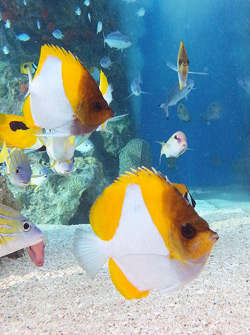While many of the butterflyfishes are challenging—if not outright impossible—to maintain in captivity for one reason or another, there are various species that go against the grain and make excellent or reasonably solid aquarium candidates. Among the “reasonably solid” species is the pyramid butterflyfish (Hemitaurichthys polylepis)—a generally hardy, adaptable, not-too-difficult-to-feed, and beautiful chaetodontid from the Indo-Pacific. I wouldn’t rate this species foolproof by any means, but it’s fairly durable as butterflyfishes go.
Physical traits
H. polylepis is highly laterally compressed (flattened from side to side—typical of butterflies) with a relatively short snout and small, terminal mouth. Its head is brownish in color, and it has a broad, white pyramid-shaped pattern on its flanks, from which its common name is derived. The caudal fin and paired fins are also white, while the rest of the body is bright yellow. Maximum length for this species is right around 7 inches.
Feeding
The pyramid butterflyfish is a zooplankton feeder, typically congregating in large shoals and snatching tiny prey items from the water column. Captive specimens will accept items like mysis shrimp, finely chopped crustacean or mollusk meat, and frozen formulas. As with most plankton feeders, H. polylepis should be fed several times per day.
Housing
Being a plankton feeder and requiring a decent amount of open swimming space, H. polylepis should be afforded a fairly decent-sized tank—at least 125 gallons in my opinion. You’ll want a tank this size or even bigger if you plan to keep a pair or small group of this species.
Compatibility
As alluded, this butterfly can be kept with others of its kind in large-enough systems, which is always refreshing since it’s so often ill-advised to keep more than one individual of a species in the same tank.
H. polylepis is relatively shy and peaceful, so heterospecific tankmates should be similar in temperament. If kept with overly aggressive species, this butterfly will likely stay in hiding and miss out at mealtimes. If moderately assertive species are to share the same tank, introduce the butterflyfish first so it can get well established and settled in before any competition arrives.
The really good news with this species when it comes to compatibility is that, being a fairly dedicated planktivore, it generally leaves sessile invertebrates alone and is, therefore, among the better butterflyfish candidates for reef systems. That’s another rarity in the chaetodontid world, which contains more than its fair share of species that will nip at or eat (sometimes exclusively) coral polyps.




